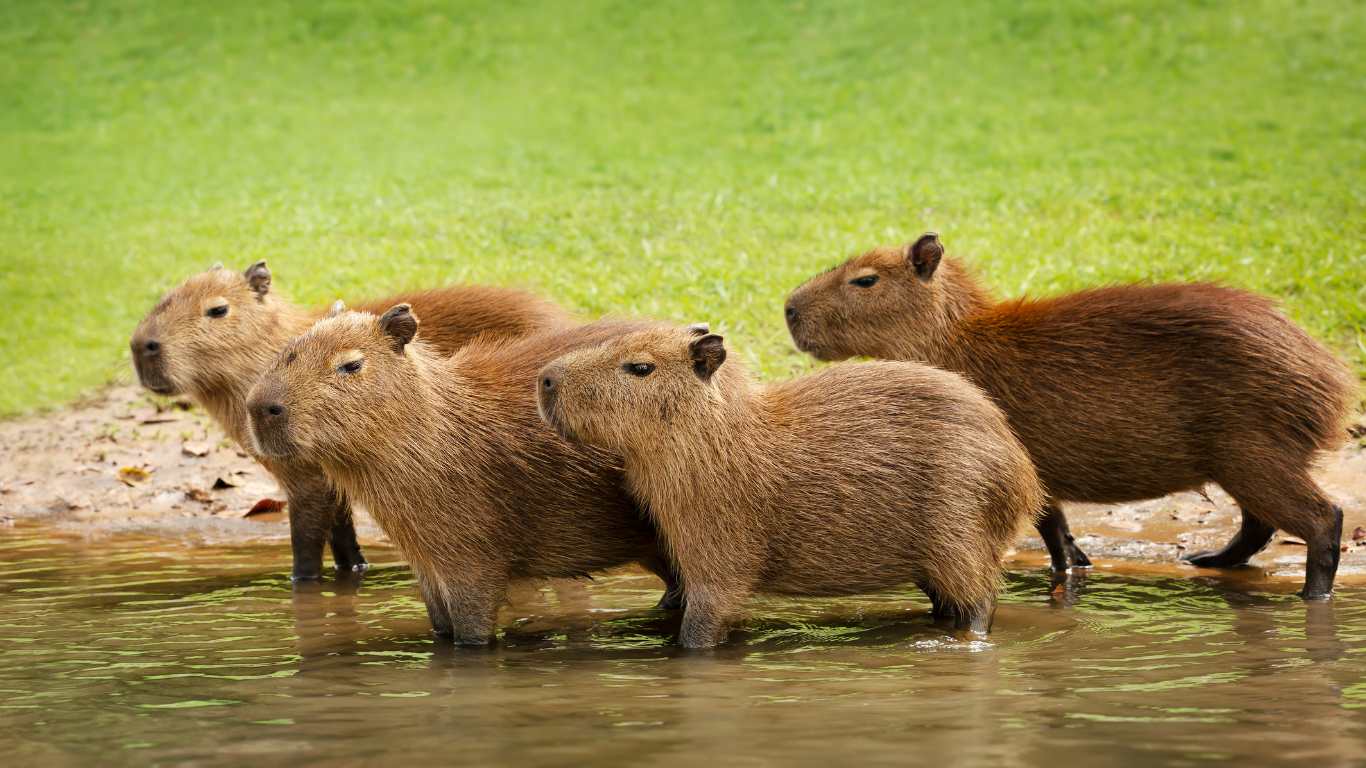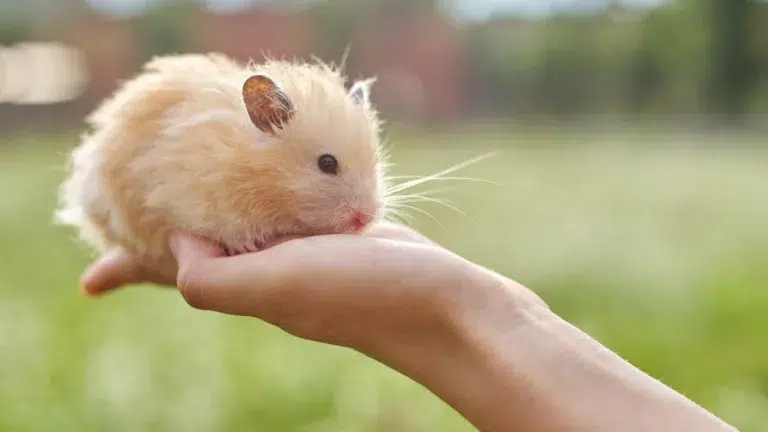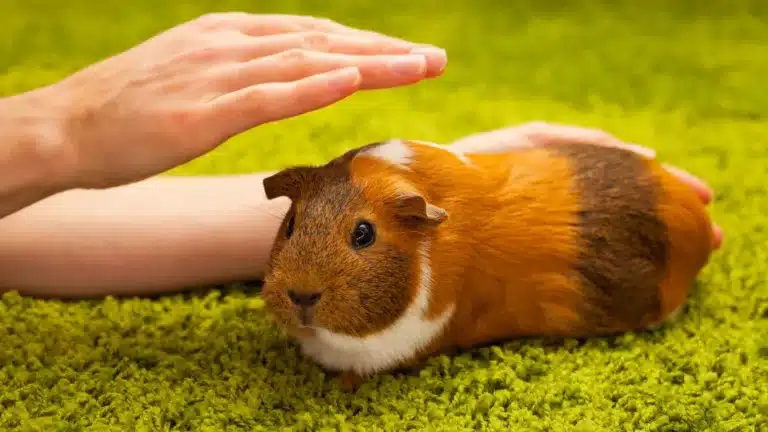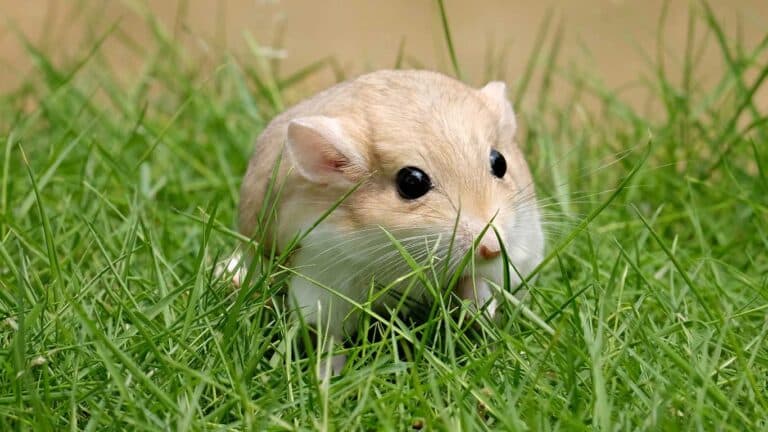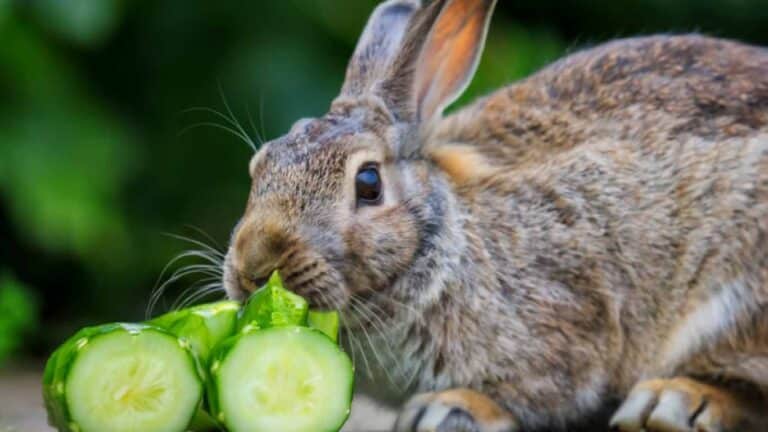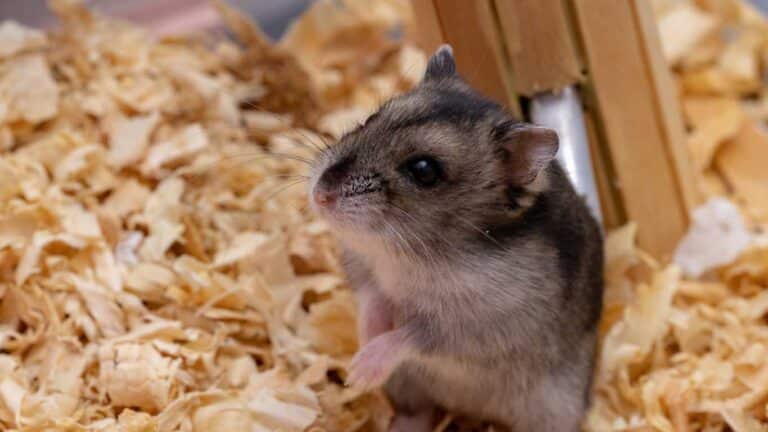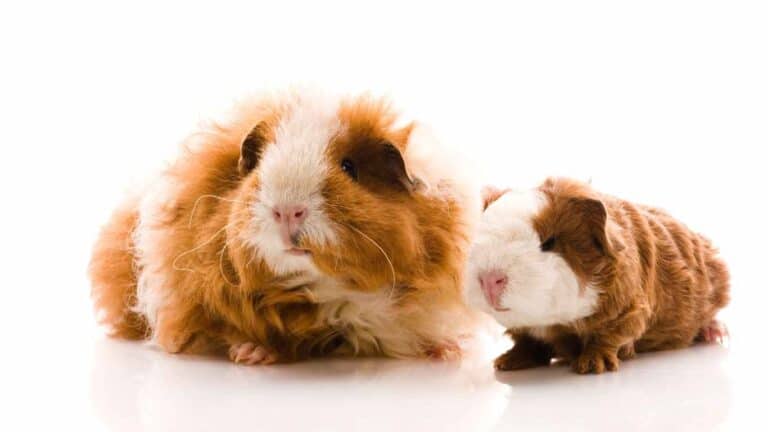Welcome to our guide on cute baby capybaras! These adorable creatures are known for their playful nature and unique characteristics. In this article, we will provide you with fascinating capybara facts and essential care tips to ensure the well-being of these remarkable animals.
Whether you are thinking of owning a baby capybara as a pet or simply want to learn more about these fascinating creatures, we’ve got you covered. From their behavior to their diet and habitat, we will delve into various aspects of capybara care.
Adorable Insights:
Baby Capybara Behavior
Baby capybaras are highly sociable animals that thrive in large family groups. They exhibit fascinating behavior as they interact with their fellow capybaras and explore their surroundings. Here are some key insights into the behavior of these adorable creatures:
Social Nature:
Baby capybaras are naturally social animals and form close-knit family units. They share a strong bond with their fellow capybaras, including their siblings, parents, and extended family members. In these groups, they engage in various social interactions, such as grooming, playing, and even taking care of each other’s young ones.
Rapid Growth and Independence:
Baby capybaras undergo remarkable growth and development within a short span of time. They are fast learners and quickly acquire the skills necessary for survival. In just one week, these little ones become independent, venturing out on their own and exploring their habitat with curiosity.
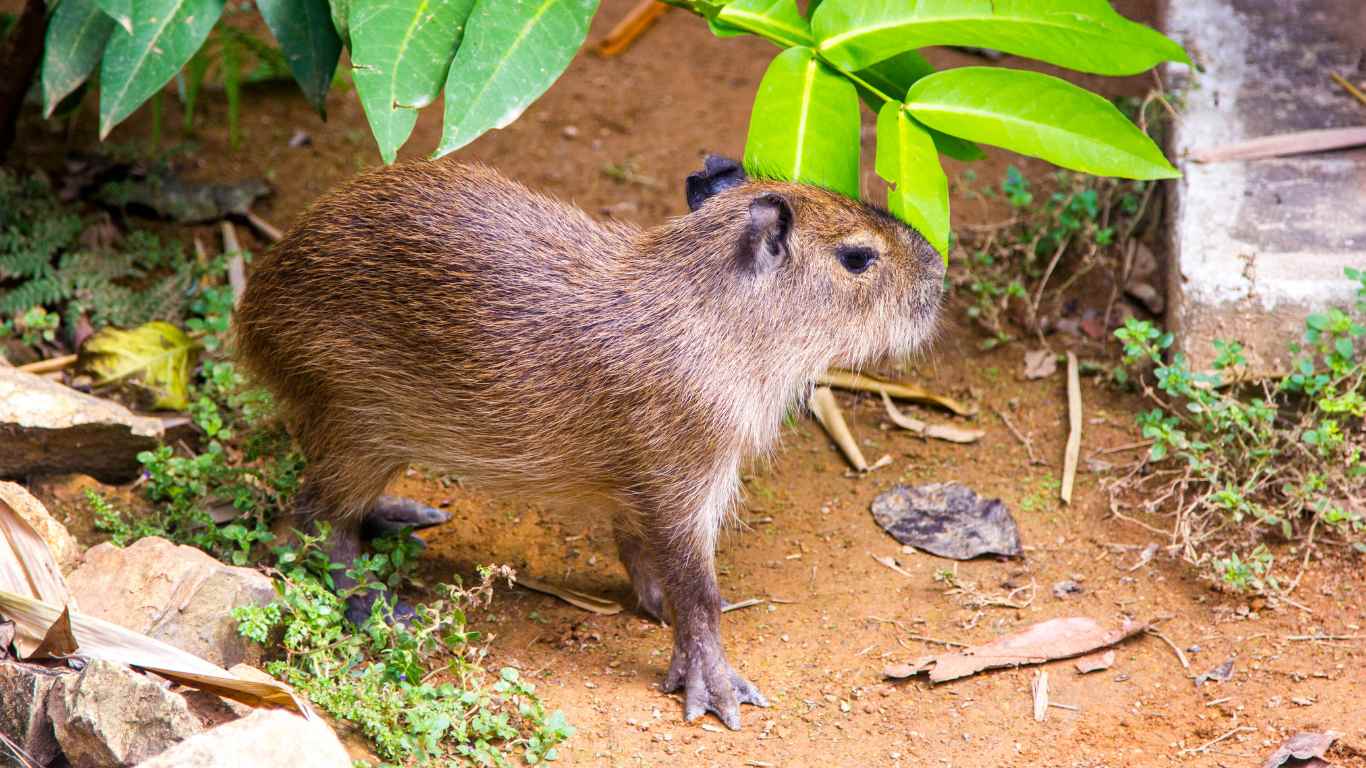
Curious Explorers:
Baby capybaras have a natural inclination to explore their environment. Their curious nature leads them to investigate new sights, sounds, and scents. They can often be seen venturing near water sources and lush vegetation, showcasing their adventurous spirit and adaptability.
“Capybaras are known for their playful nature, and baby capybaras are no exception. They enjoy frolicking in the water, rolling in mud, and engaging in friendly chase games with their siblings. Their adorable antics can bring a smile to anyone’s face.”
Bonding with Owners:
While baby capybaras form strong bonds within their family groups, they can also establish connections with their human owners. However, it’s important to note that capybaras may assert their dominance in these relationships. They may display a preference for being the leader and expect respect from their owners. Building trust through positive reinforcement and bonding activities, such as sharing mealtimes, can strengthen the human-capybara relationship.
To get a glimpse of the adorable behavior of baby capybaras, take a look at these cute pictures:
| Behavior | Description |
|---|---|
| Playfulness | Baby capybaras are highly playful, engaging in chase games and water-related activities. |
| Grooming | They engage in mutual grooming, strengthening social bonds within their family groups. |
| Curious Exploration | These little explorers are curious about their surroundings and exhibit a sense of adventure. |
| Leadership | Baby capybaras may assert dominance, often expecting respect from their human owners. |
Observing the behavior of baby capybaras can be an enchanting experience. In their natural habitat or as pets, these gentle and sociable creatures continue to captivate animal lovers worldwide.
Capybara Facts and Size
When it comes to rodents, the capybara takes the crown for being the largest in the world. These fascinating creatures measure about 1.5 feet tall at the shoulder and can reach lengths of up to 4 feet. With their impressive size, capybaras weigh between 75 to 150 pounds, making them quite substantial compared to other rodents.
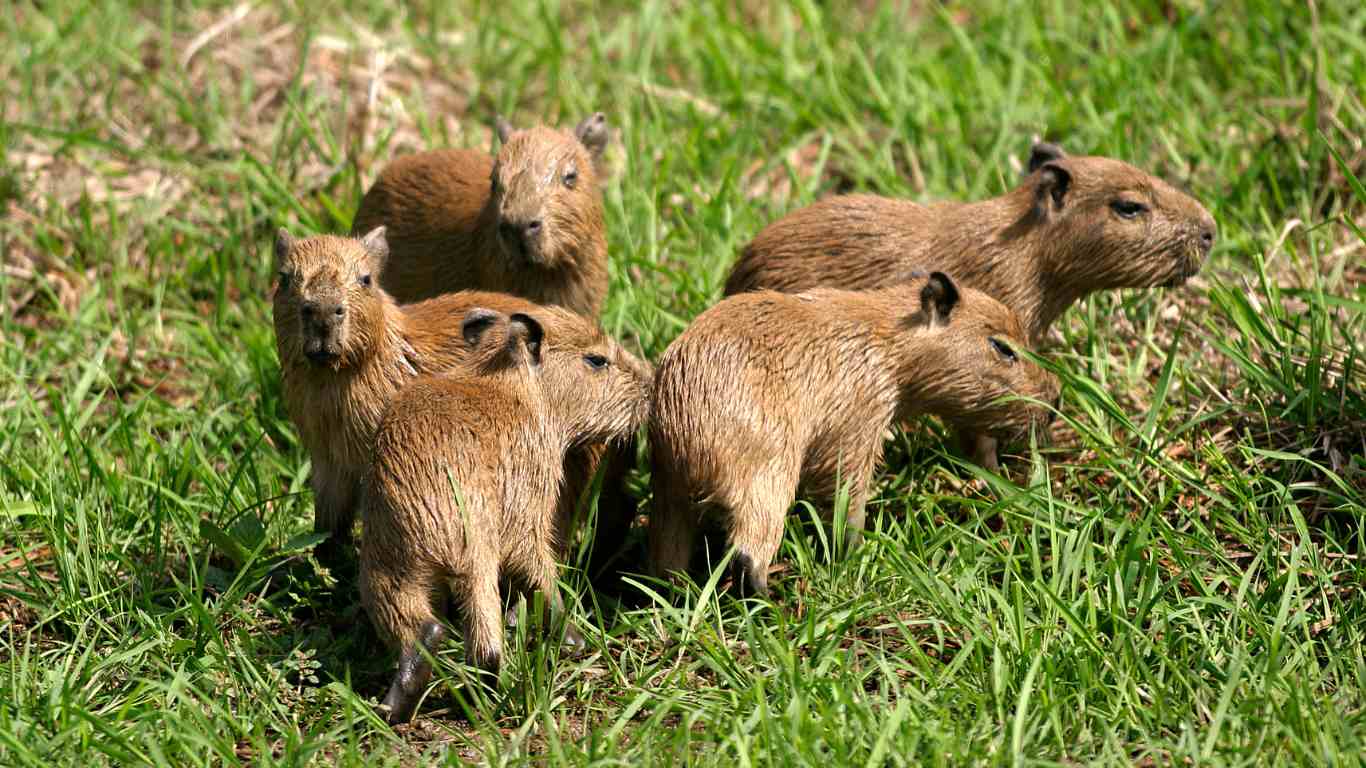
One of the distinctive characteristics of capybaras is their semi-aquatic nature. They spend a significant amount of time in the water, making them the perfect swimmers. Their webbed feet allow them to move effortlessly in the water and navigate through soft, muddy ground with ease.
Capybaras can be found in the savannas and rainforests of southern Central America and northern South America. They thrive in habitats near ponds, rivers, or lakes, where they can easily access their favorite element – water. As semi-aquatic animals, capybaras have adapted to their environment with features that facilitate their aquatic lifestyle.
When it comes to their appearance, capybaras have a thin coat of coarse hair that helps them dry quickly when they emerge from the water. This unique adaptation ensures that they don’t remain wet for extended periods, preventing any discomfort or potential health issues.
Now that you know more about capybaras’ impressive size and semi-aquatic nature, let’s dive into their fascinating diet and nutritional needs.
Capybara Diet
When it comes to food, capybaras have a unique diet that consists mainly of grasses and aquatic plants. These adorable herbivores consume an impressive amount of food each day, typically ranging from 6 to 8 pounds. Their digestive system is specially designed to handle their highly fibrous diet, allowing them to efficiently absorb nutrients.
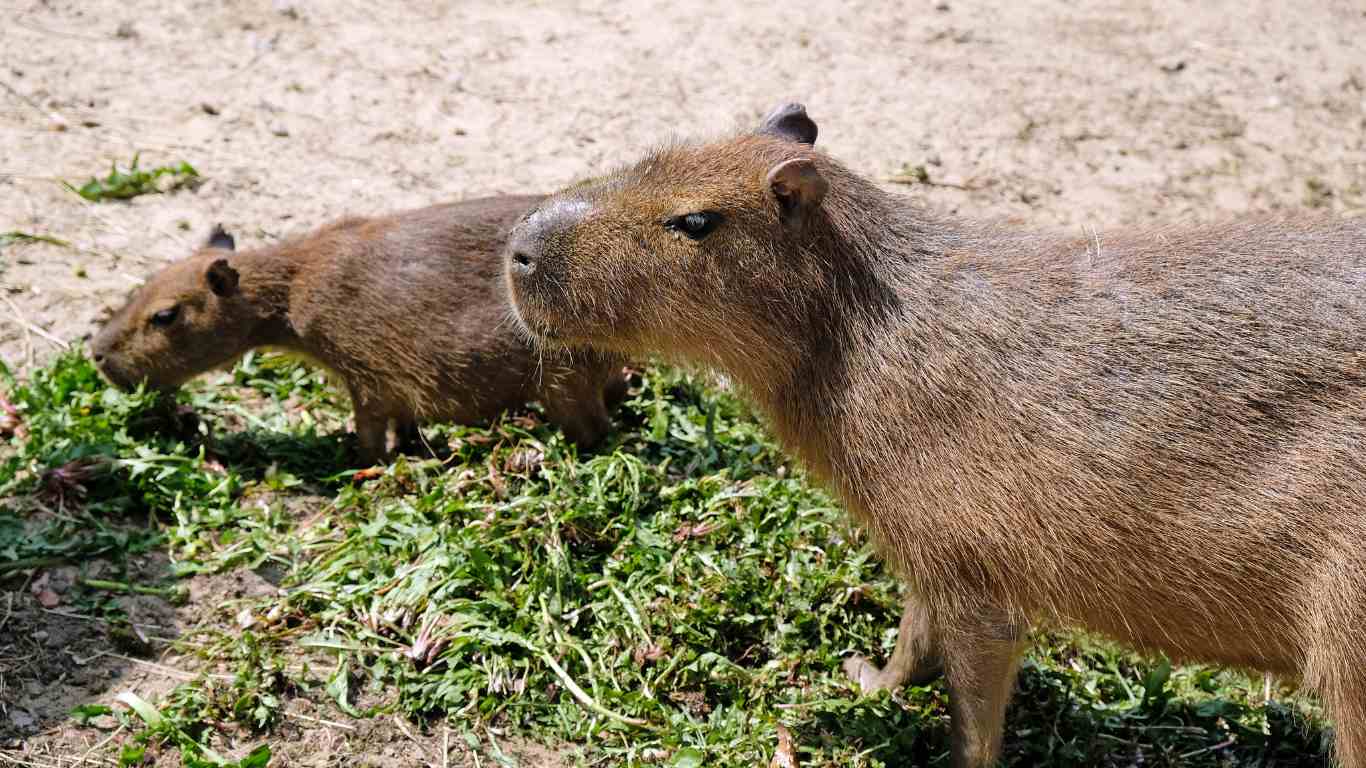
One remarkable feature of a capybara’s digestive system is the presence of a large fermentation chamber in their intestines. This chamber serves as a crucial site where the fibrous materials they consume are broken down with the help of bacteria, enzymes, and gases. This fermentation process aids in the digestion of the tough plant fibers, enabling capybaras to extract valuable nutrients from their food.
Additionally, capybaras engage in a fascinating behavior known as coprophagy. Despite the initial aversion one might feel toward this practice, it serves a vital purpose for capybaras. This behavior involves the consumption of their own droppings as a means of obtaining additional nutrients and proteins. By re-ingesting their partially digested food, capybaras are able to extract any remaining nutrients that may have been missed during the initial digestion process.
This unique dietary adaptation enables capybaras to thrive on a diet mainly composed of plant material, ensuring they receive the essential nutrients required for their overall health and well-being.
Capybara Diet Summary:
| Food | Portion Size | Additional Information |
|---|---|---|
| Grasses | High consumption | Main staple of their diet |
| Aquatic plants | Regular inclusion | Provides variety and additional nutrition |
| Own droppings (coprophagy) | Periodic consumption | Extracts any remaining nutrients |
As you can see, capybaras have a fascinating dietary regimen that revolves around grasses, aquatic plants, and even the consumption of their own droppings. This specialized diet enables them to meet their nutritional needs while thriving in their natural environment.
Join the Pet Planet Diaries
Sign up for our newsletter to get the latest tips, stories, and exclusive insights into the wonderful world of pets.
Capybara Habitat
Capybaras inhabit the diverse landscapes of southern Central America and northern South America. They can be found in both savannas and rainforests, thriving near ponds, rivers, and lakes. Their natural habitat provides them with the constant source of water they require for their semi-aquatic lifestyle.
Although capybaras are well-adapted to their environments, they face threats from predators such as jaguars, anacondas, and pumas. To protect themselves, capybaras often retreat into murky waters, seeking safety and camouflage.
Capybaras have unique physical adaptations to their semi-aquatic homes. They possess webbed feet, which enable efficient swimming, and they are capable of staying submerged for up to 5 minutes.
During the hottest parts of the day, capybaras prefer to seek refuge in water or shady areas to escape the sweltering heat. Their habitat provides them with the necessary elements to thrive in their social groups and maintain a comfortable lifestyle.
Capybara Care
Baby capybaras require special care to ensure their survival. It is important to provide them with a nurturing environment and meet their specific needs. Here are some guidelines to help you take care of your capybara:

Early Life
The first few weeks are crucial for the well-being of baby capybaras. It is recommended not to separate them from their mothers before they are 7 to 14 days old. During this time, they rely on their mother for nutrition and protection.
Life begins in a confined area with a heated cage to keep them warm and comfortable. Warm milk with added sugar and Puppy Chow should be provided for feeding. This combination provides the essential nutrients required for their growth.
Growing Up
As baby capybaras grow, they need more space to move around and explore their surroundings. Transition them to a yard with a source of heat and access to clean water. This will allow them to engage in natural behaviors and develop their physical abilities.
To prevent escape and ensure their safety, it is important to have a secure pen area. This will give them the freedom to roam while still being contained in a controlled environment.
Diet
A healthy diet is essential for the well-being of capybaras. Their diet should consist of a variety of fruits, vegetables, and foods rich in fiber. This will help them maintain good digestive health and overall nutrition.
Here is an example of a balanced capybara diet:
| Food Group | Examples |
|---|---|
| Fruits | Apples, bananas, watermelon |
| Vegetables | Carrots, leafy greens, bell peppers |
| Grains | Rice, oats, whole wheat |
| Hay | Timothy, alfalfa |
Nutrition and Hydration
Proper nutrition and clean water are of utmost importance for capybaras. They should have access to fresh water at all times, as well as regular meals that meet their dietary requirements. Regularly monitor their food intake and adjust their diet if necessary to maintain their optimal weight and health.
“Providing a nurturing environment and meeting the specific needs of baby capybaras is essential for their well-being and development.”
By following these guidelines, you can ensure that your capybaras receive the care they need to thrive. Proper care will help them grow into healthy and happy pets that bring joy and companionship to your life.
Capybara Lifespan
When it comes to the lifespan of capybaras, various factors come into play. In the wild, capybaras typically have an average lifespan of 8 to 10 years. However, in captivity, they have been known to live up to 12 years, thanks to the availability of proper care and nutrition.
The lifespan of capybaras can be influenced by several factors, including their natural habitat, diet, and access to healthcare. In the wild, young capybaras are particularly vulnerable to predation as they are still developing their swimming skills. Animals like foxes, vultures, and piranhas prey on them during this stage.
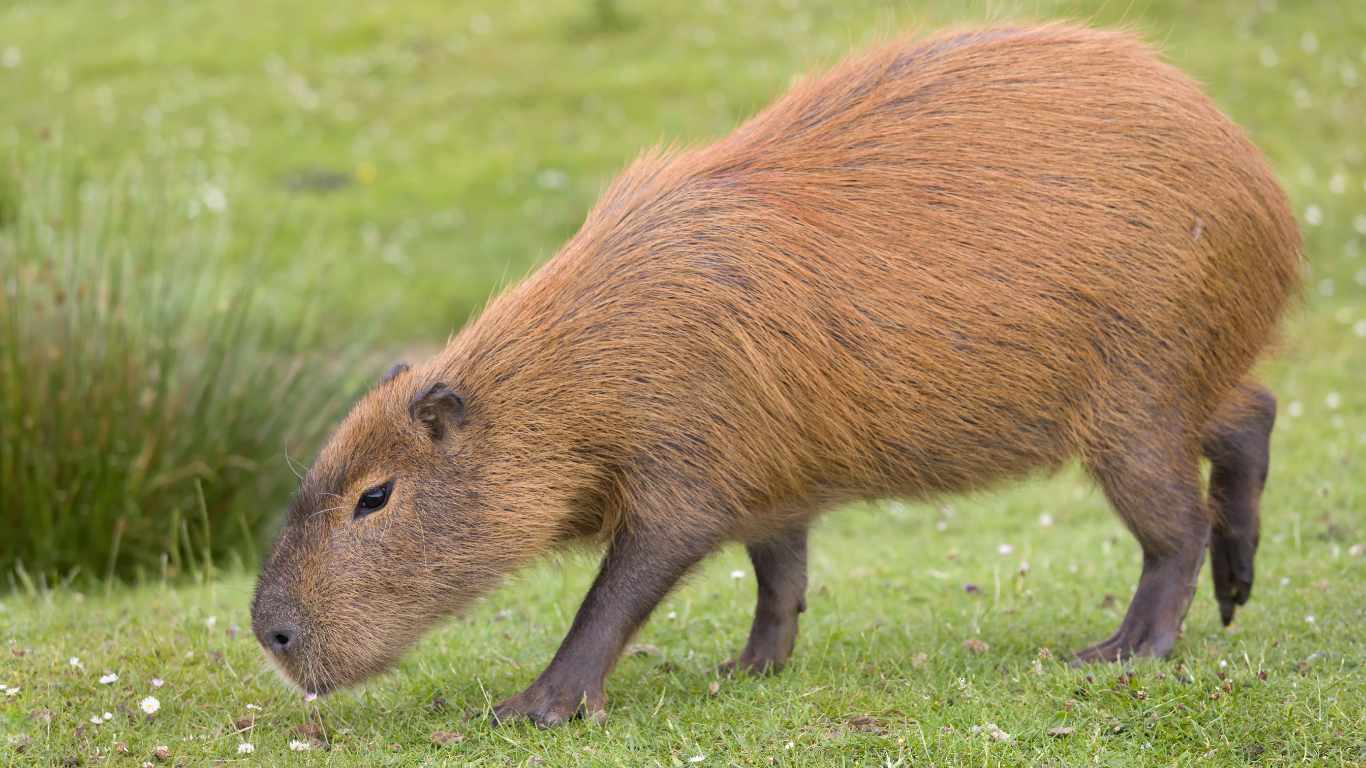
Fortunately, conservation efforts and hunting restrictions have played a crucial role in stabilizing capybara populations in certain regions. By protecting these gentle creatures and their natural habitats, we can contribute to their overall survival and ensure their lifespan is extended.
Conservation Efforts
Conservation plays a major role in securing the future of capybara populations. By raising awareness and implementing protective measures, we can help preserve their habitats and safeguard them from other threats. Protecting capybaras means safeguarding the delicate balance of their ecosystems and ensuring their contribution to the overall biodiversity remains intact.
Capybara Lifespan Comparison
| Capybara | Average Lifespan (Wild) | Average Lifespan (Captivity) |
|---|---|---|
| 8 to 10 years | 12 years (maximum) |
Capybara Reproduction
When it comes to capybara reproduction, things get interesting in the water. The dominant male capybara in a group mates with all the females, ensuring the continuation of their genes. This behavior is known as polygyny. After a gestation period of approximately 5 months, the female capybara gives birth to an average of four to five adorable baby capybaras.
Upon entering the world, these little ones remain on land, hiding under brushy cover for protection. They are communally nursed by all the females in the group, ensuring their nourishment and growth. Within just one week, the baby capybaras begin to explore their environment and nibble on plants.
As they continue to develop, baby capybaras are weaned at around 16 weeks, transitioning to a diet primarily consisting of plants. It’s amazing how quickly they become self-sufficient and independent. Within a year, capybaras reach sexual maturity, and the dominant male plays a vital role in protecting the females and their offspring from other males.
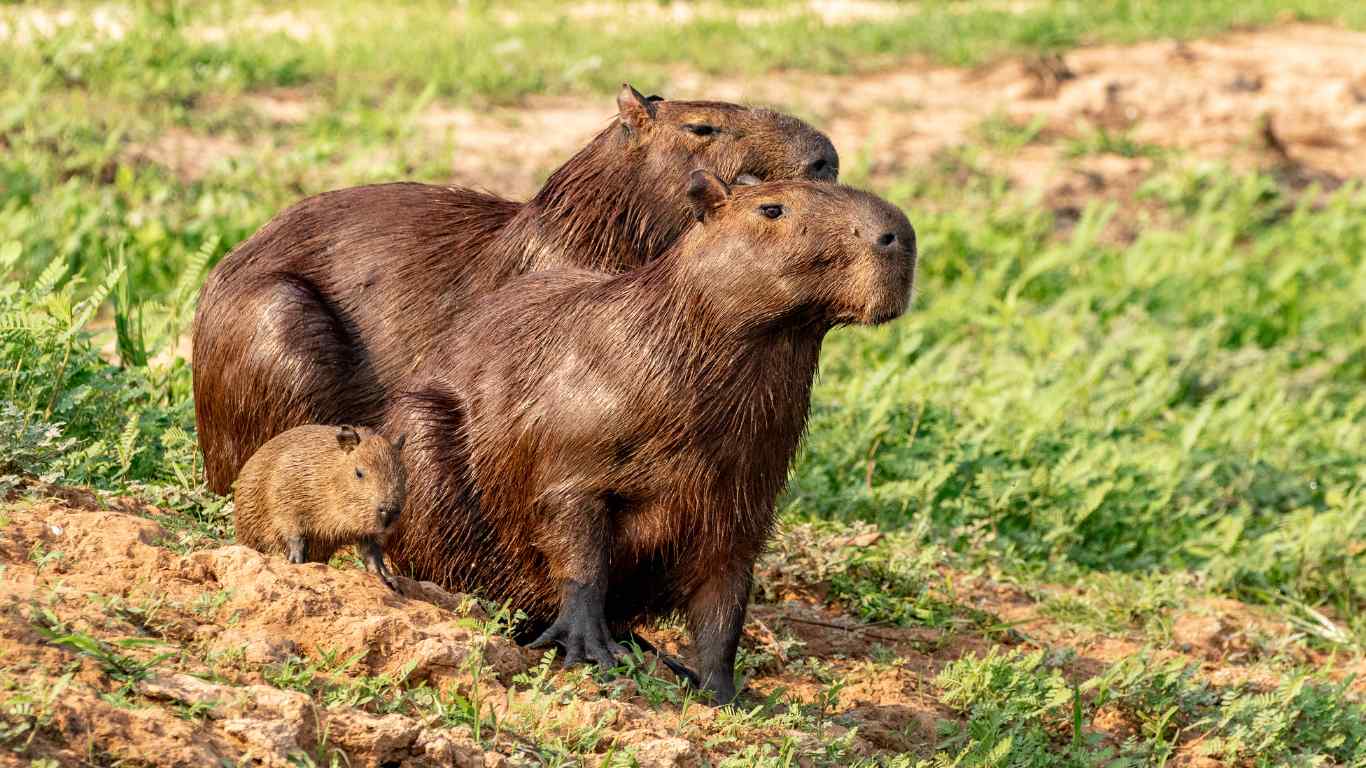
Overall, capybara reproduction showcases fascinating social dynamics within their group and allows for the growth of their closely-knit capybara family.
For a visual representation of these adorable baby capybaras, take a look at the image above
| Reproduction Facts | |
|---|---|
| Average Gestation Period | Approximately 5 months |
| Average Number of Babies | 4 to 5 |
| Nursing Period | Communally nursed by all females in the group |
| Independence and Weaning | Start eating plants after a week and weaned at around 16 weeks |
| Sexual Maturity | Within a year |
Capybara Conservation Status
Capybaras are currently listed as “least concern” on the IUCN Red List, indicating that their populations have been relatively stable in many regions. However, these fascinating creatures have faced threats in the past, particularly from hunting for their meat and skin.
Hunting restrictions and conservation efforts have played a vital role in protecting capybara populations and ensuring their continued survival. Conserving these gentle giants is essential for maintaining biodiversity and preserving their significant ecological contributions.
As highly social animals, capybaras contribute to the balance of their ecosystems. They participate in seed dispersal through their grazing habits, helping to regenerate plant populations. Additionally, their role in providing prey for predators strengthens the intricate web of life in their habitats.
Understanding the behavior and habitat requirements of capybaras is crucial in formulating effective conservation strategies. By safeguarding their natural habitats and creating protected areas, we can ensure the long-term survival of capybaras and the ecosystems they inhabit.
The Role of Conservation Organizations
Conservation organizations such as the Capybara Conservation Society and the International Union for Conservation of Nature (IUCN) are actively working to protect capybara populations and their habitats.
These organizations collaborate with local communities, researchers, and government authorities to raise awareness about capybara conservation and enact policies for their preservation. Through education and outreach programs, they promote sustainable practices that benefit both capybaras and the environment.
Furthermore, ongoing research and monitoring efforts provide valuable insights into capybara behavior, population trends, and the ecological impact of conservation initiatives. This knowledge guides conservation actions and ensures the implementation of effective measures to safeguard capybaras and their habitats for future generations.
| Threats to Capybaras | Conservation Actions |
|---|---|
| Hunting for meat and skin | Hunting restrictions and regulations |
| Habitat loss and fragmentation | Creation of protected areas and habitat conservation |
| Predation by natural predators | Enhanced predator management and monitoring |
| Human-wildlife conflict | Community-based conservation initiatives |
| Climate change and habitat alteration | Sustainable land use practices and climate resilience strategies |
Final Remarks
As you’ve learned, baby capybaras are truly fascinating creatures that require special care and attention. From their adorable birth on land to quickly joining a large family group, these curious animals are fast learners, growing and exploring their environment within just a week.
Capybaras, as the world’s largest rodents, have unique adaptations for their semi-aquatic lifestyle. They enjoy a diet consisting of grasses and aquatic plants, thanks to their special digestive system that efficiently absorbs nutrients. With proper care, capybaras can lead a happy and healthy life.
So, if you’re considering a baby capybara as a pet, make sure to provide them with a secure and spacious habitat, a balanced diet rich in fruits and vegetables, and plenty of clean water. Remember to let them be the boss and use positive reinforcement to bond with them. By following these care tips, you can ensure a wonderful companionship with your baby capybara.
FAQ
Can I keep a baby capybara as a pet?
Yes, it is possible to keep a baby capybara as a pet. However, they require special care and attention, and it’s important to understand their unique needs and behavior before considering them as pets.
How big do baby capybaras get?
Baby capybaras are born small, measuring about 1.5 feet tall at the shoulder and up to 4 feet in length. They can weigh between 75 to 150 pounds when fully grown.
What do baby capybaras eat?
Baby capybaras start eating grass after the first week of their birth. As they grow, their diet includes grasses and aquatic plants. They can consume around 6 to 8 pounds of food per day.
Where do capybaras live?
Capybaras inhabit savannas and rainforests near ponds, rivers, or lakes in southern Central America and northern South America. They require a constant source of water and often spend time in the water to escape from predators and regulate their body temperature.
What is the lifespan of a capybara?
In the wild, capybaras have an average lifespan of 8 to 10 years, while in captivity, they can live up to 12 years. Their lifespan is influenced by various factors such as habitat, diet, and access to healthcare.
How do capybaras reproduce?
Capybaras mate in the water, with the dominant male mating with all the females in the group. After a gestation period of 5 months, the female gives birth to an average of four to five babies. The babies are born on land and are communally nursed by all the females in the group.
What is the conservation status of capybaras?
Capybaras are currently listed as “least concern” on the IUCN Red List. While they have been affected by hunting in the past, hunting restrictions and conservation efforts have helped protect capybara populations and stabilize their numbers in many regions.

